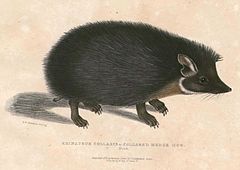Indian long-eared hedgehog
| Indian long-eared hedgehog | |
|---|---|
 |
|
| Indian long-eared hedgehog in captivity | |
| Scientific classification | |
| Kingdom: | Animalia |
| Phylum: | Chordata |
| Class: | Mammalia |
| Order: | Eulipotyphla |
| Family: | Erinaceidae |
| Genus: | Hemiechinus |
| Species: | H. collaris |
| Binomial name | |
|
Hemiechinus collaris (Gray, 1830) |
|
 |
|
| Indian long-eared hedgehog range | |
The Indian long-eared hedgehog (Hemiechinus collaris) is a relatively small hedgehog (~17 cm, 200–500 grams) native to India. It is insectivorous and nocturnal.
The Indian long-eared hedgehog is a nocturnal animal that is often found inhabiting burrows. Similar to most hedgehogs it has spines on its back, embedded into a muscle sheath. This sheath forms a bag-like structure that the animal can hide inside for protection. It can also erect its spines to further protect from predators. The Indian long-eared hedgehog has a well developed set of senses because of its large ears, eyes and whiskers near its snout. These senses, especially smell, help them find food and/or a possible partner.
The Indian long-eared hedgehog is insectivorous, feeding on small insects. Because of their arid desert habitat they often receive most of the water they need from their food supply.
The Indian long-eared hedgehog is found in Pakistan (North West Frontier Province, Punjab and Sindh) and India (Gujarat, Rajasthan and Uttar Pradesh. It experiences extreme heat in the months of May and June and very cold weather in December and January.
They are seasonal breeders. The males are active from March to August while the females are active from April to August. It is notable for a quite complex mating ritual that involves "dancing" around females for several days before mating.
...
Wikipedia

